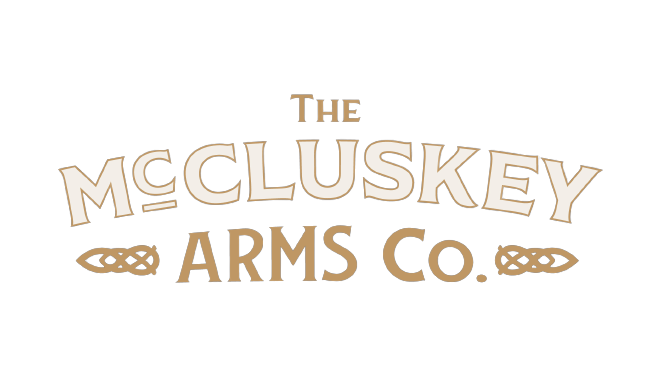How to Machine Optic Cuts on a Manual Mill
At McCluskey Arms, we machine our optic cuts with a CNC mill. But, when I first started McCluskey Arms, we were working out of our garage and used just a manual mill.
I’ve seen a lot of gunsmiths machine rectangular optic cuts and forego the machining required to fit the optic’s front radius. This blog will explain how gunsmiths can make a fixture and use a manual machine to make a perfect fitting optic cut for the front radius.
Tools needed
Rotary Table
To machine the radius on your manual mill, you’ll need to use a rotary table bolted flat onto the mill. The rotary table should be a minimum of 6 inches but ideally it’s a 10 inch one.
If you don't have a rotary table, you can pick up a used one for $300 to $500. While that might sound like a lot, you can pay for it in just a few optic cuts. And, to put that in perspective, high quality, new rotary tables can cost up to $3,000.
Mild Steel Plate
On top of the rotary table, you’ll need to bolt a plate on which you can mill a fixture.
The plate should be mild steel and ¼ inch or 5/16 inch thick. Ideally it’s round to match the rotary table but square will also work. The plate should be roughly the size of the rotary table.
Drill a hole into the middle the same diameter as the hole in the middle of the rotary table. This will allow you to use an alignment pin to align the plate with the table.
You can fix about eight fixtures on one plate. Each fixture will be specific to each slide, optic, and position on the slide. For example, you can do a Glock 43X slide with an RMRcc optic and an irons delete cut. But that same fixture won't work for a different slide, optic, or for an irons forward cut. You'd have to make another fixture.
How to machine the fixture
You’ll need to machine a channel into the plate that will allow you to set the slide the perfect distance from the center of the rotary table. This will enable you to achieve the correct radius for the front of the optic in the correct position.
The channel dimensions will be based off of the spindle of the mill centered over the center of the rotary table.
Here’s an example on a Glock 19 irons delete cut for a RM06:
The Glock 19 slide is 1.010 inches wide. This means that the channel should be the same width and centered on the x axis.
The RM06 is 1.780 inches long from the flat rear to the tip of the front radius, and the front radius of the RM06 is 3 inches.
On a Glock 19 Irons Delete, we put the optic rear 0.2 inches from the rear of the slide. This means that the apex of the front radius of the optic needs to be 1.980 inches from the rear of the gun (1.780 + 0.2 = 1.980).
The channel for the slide needs to be positioned in a manner that the back of the slide is 1.98 inches away from the 3 inch point of the rotary table. And 3 inches minus 1.980 is 1.02 (3.0 - 1.980 = 1.02) so the rear of the channel needs to be machined 1.02 inches away from the center.
If you mill that channel 1.01 inches wide and so that it stops 1.02 inches from the middle of the rotary table, you should be able to set the slide in the channel so that the rotary table generates the 3 inch front radius of the RM06 in the correct position.
How to machine the optic cut with a radius
STep 1: Holding down the slide
You'll need to machine a hold down system for the slide. I like to use a drilled hole through where the chamber would be and bolt through a plate that holds down the slide .
You can also use toe clamps or your machinist hold down kit.
STep 2: Indicate the straightness
Once you have the slide positioned correctly and bolted down to your fixture, you’ll need to use an indicator to make sure the slide is perfectly straight. Adjust the straightness on your rotary table until there's no run-out along the x axis.
STep 3: Mill until the radius
Mill the rectangle part of the optic cut and stop short of the beginning of the radius.
STep 4: Drill & Tap
Drill and tap your holes before machining the radius. Otherwise you'll have to indicate the straightness.
STep 5: Machine the radius in increments
Start machining the radius by using the rotary table to move the slide rather than the x/y movement of your table. Do so in 5000th increments. Machine it closer and closer to the 3 inch radius in these small increments.
Bonus tip
If you are interested in doing the recoil lugs, you can do it with a custom made annular cutter. Or you can drill a hole in the location of the recoil lug in the same diameter, and then press a pin into the hole so it sits proud.
Next Up
We hope you enjoyed this week’s blog. Thank you for following along! New posts are released every Tuesday at 10am PST. Please comment for any content you want to see.
If you loved the services you saw today, check out our online store! You can start shopping by clicking here. Or drop us a message here. We look forward to meeting you and gunsmithing for you.
Please subscribe to our blog below and don’t forget to follow us on social media!


